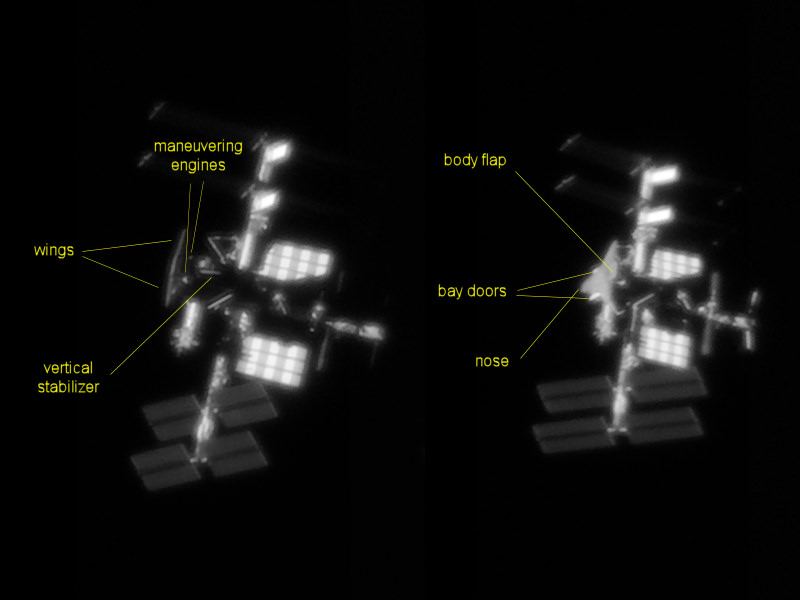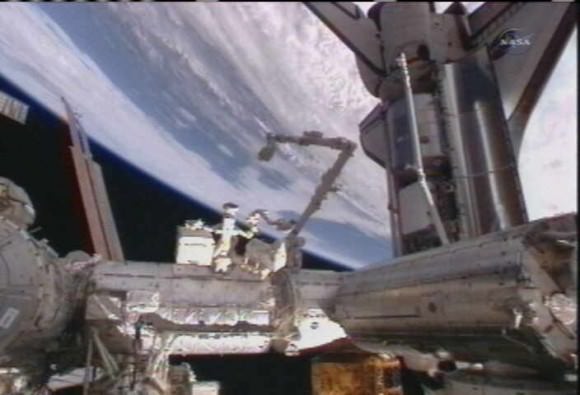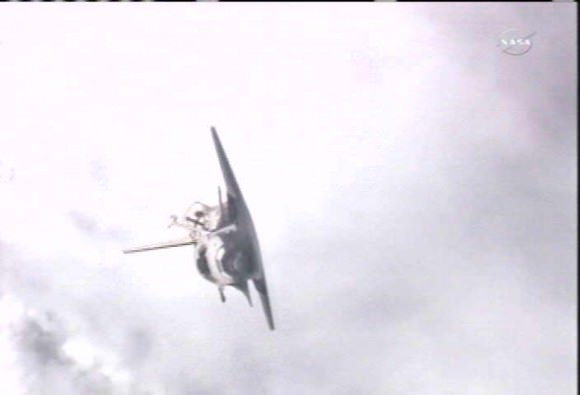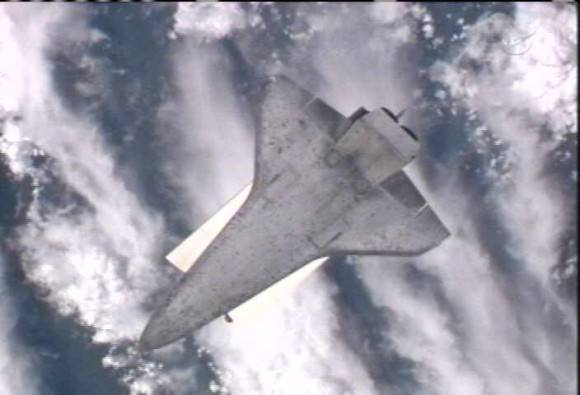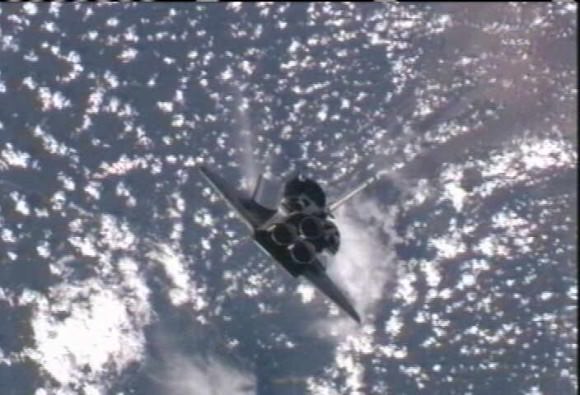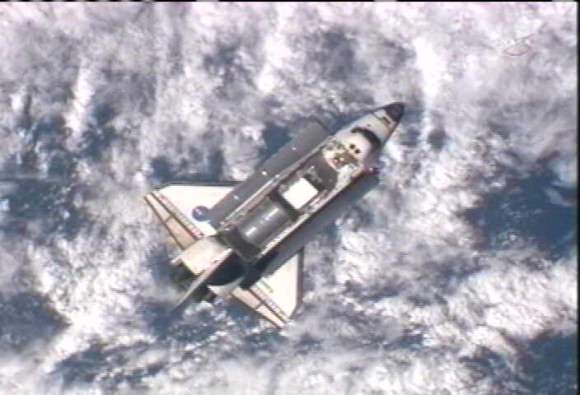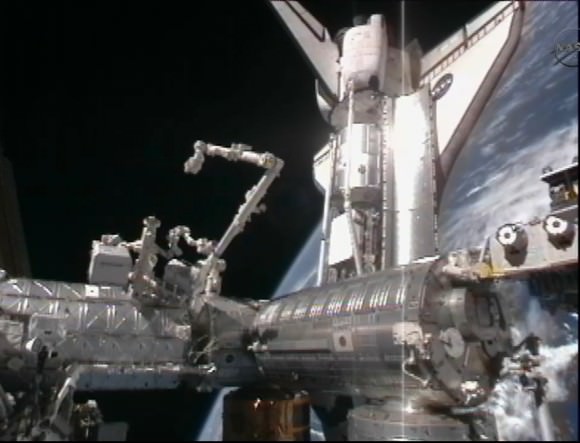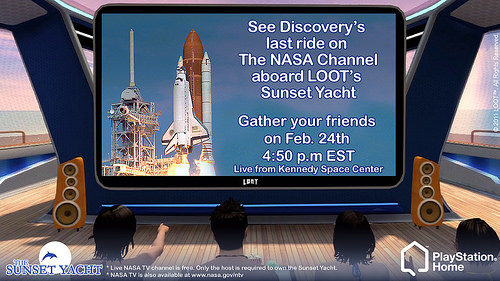I always enjoy the views from the cameras placed on the solid rocket boosters for the space shuttles, and this one is no different. Enjoy the ride and and down again, and watch out for that splashdown!
Space Station 3-D by Thierry Legault
[/caption]
Run — don’t walk — to astrophotographer Thierry Legault’s website to see his latest incredible video of the International Space Station and a docked space shuttle Discovery. He sent us a note that he had great “seeing” from Weimar, Germany on Monday evening, where he has set up shop in order to capture the orbiting spacecraft as many times as possible during the STS-133 mission. The detail is stunning, — more detail even than his previous video from last weekend — as evidenced in the annotated image above. Legault has even created a 3-D movie — no special 3-D glasses required. He has instructions on his website of how to cross your eyes and squint to get the 3-D effect. “This method may require a bit of training if you are not used to squinting but it gives a very realistic view,” Legault explained. See the videos and find out how he creates these amazing views on his website.
No-go for ‘Fly About’ Photo-Op at Space Station
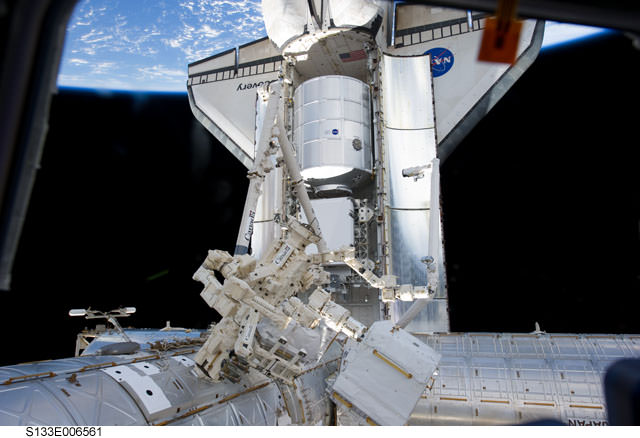
[/caption]
The international partners have decided against an historic ‘fly-about’ of the International Space Station, which would have provided one-of-a-kind images of the nearly completed ISS with space shuttle Discovery and an assortment of vehicles from the different participating space agencies docked to the station.
“This morning, our Russian colleagues, after doing their own independent review processes … have determined that they are not in position to recommend doing the fly about, because this particular vehicle is what they consider a new vehicle, the Series 700 vehicle, which is in its maiden flight,” said Kenneth Todd, a manager for Mission Integration and Operations at NASA, speaking at a mission briefing this morning.
The Russians felt they didn’t have the time or opportunity to fully understand, review and work through all the risks of the request of flying the Soyuz around the ISS, an idea which was presented only recently, and after the new Soyuz had already launched to orbit.
“From a MMT perspective, we knew it was critical for all partners to go through their processes,” Todd said. “It wasn’t necessarily what we were hoping to get back, but at the same point I applaud the Russians for doing the right thing, for not disregarding their own processes and making sure they do their own due diligence the way they should. I accepted the recommendation.”
Mission Control in Houston radioed up to ISS commander Scott Kelly and STS-133 Commander Steve Lindsey that the possible Soyuz fly about was a no-go, even though mission managers had already approved an extra day extension of the shuttle mission.
“We’ll now use that extra day for transfer work between the PMM (Permanent Multipurpose Module) and the ISS, to leave the station and crew in the best possible shape when Discovery undocks.” said Capcom Stan Love. “The fly about will not happen during this flight.”
The fly-about –- only proposed about two weeks ago — would have had cosmonauts Alexander Kaleri and Oleg Skripochka along with Kelly to undock from the Russian Poisk module in the Soyuz TMA-01M spacecraft, back away from the ISS so they could show the ISS in its nearly completed configuration, with the shuttle attached, along with the Russian Progress and Soyuz, the European ATV and the Japanese HTV-1.
Todd said the images would not only be historic from an aesthetic perspective, but also provide valuable engineering views and data.
“There are multiple reasons this was going to be a good thing, to do this photo documentation,” he said. “Everytime we do one of these things we learn a lot, and we get a lot of good data about our ability to do this type of function, not just on our side but on the Russian side. I don’t see our review of this as wasted time or effort, and if we ever need to do this in the future, we will have to assess that at the time.”
Todd added that they should be able to get most of the images and data they were hoping for when the shuttle undocks and departs from the ISS next week – save for the historic aspect of having a shuttle docked to the station, along with all the other visiting vehicles.
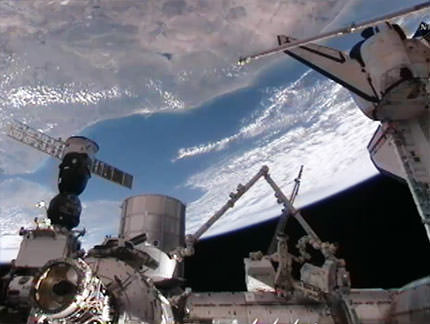
Earlier today, the crews of STS-133 and the space station successfully installed the Leonardo Permanent Multipurpose Module, essentially storage space (a “float-in” closet – which has also been referred to as a potential Man-cave) which includes supplies. Also tucked inside is Robonaut-2, the first human-like robot to serve on board the space station.
Discovery’s landing is currently set for 11:36 am EST on Tuesday, March 8, 2011.
Unique Perspective: Shuttle Launch as Seen from Airplane, Balloon, and Freefall
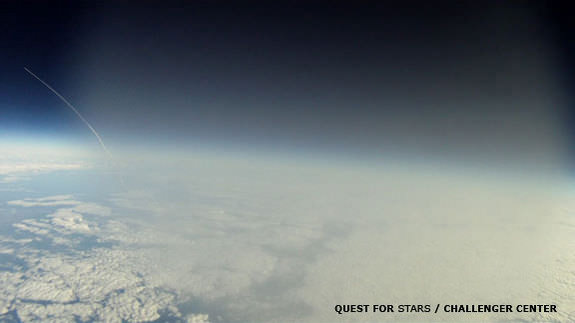
I thought I had a great view of space shuttle Discovery’s final launch, seeing it from the Kennedy Space Center press site. But there were a few other people who had a pretty unique perspective on the launch. A passenger on an airplane, Neil Monday, who was flying out of the Orlando, Florida airport, recorded the shuttle launch with his iPhone, above. That is just awesome. Want more unique views of the launch?
[/caption]
The students from Quest For Stars who were attempting to capture an image of Discovery’s launch from a high altitude balloon (see our preview article) were successful and the team has released a couple of images, including the one above. They say they will be releasing the “best of the best” of their images later this week at the Next Generation Suborbital Research conference. They have a great video of their balloon popping, sending their payload into a quick freefall.
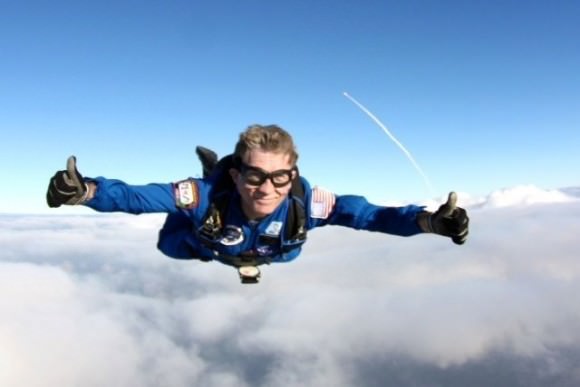
Speaking of freefall, former astronaut Fred Leslie and his wife Kathy wanted to do something special to commemorate Discovery’s final launch. They jumped from an aircraft over Deland, Fla., and timed it so they could get a photograph with Discovery taking off in the background. Read more about it in the Huntsville Times.
And of course, if you want to see more launch images, we have a great gallery of the STS-133 launch as seen by our cadre of reporters and photographers who were on hand for Discovery’s historic launch.
Incredible Video of Shuttle Approaching ISS, Taken from Earth

[/caption]
Award winning photographer Theirry Legault sent us a note about some amazing new video he shot of the space shuttle Discovery getting ready to dock with the space station. Legault took the video on Saturday evening (Feb. 26, 2011) at 18:40 UT from Germany, showing Discovery and the ISS about a hundred meters apart, 30 minutes before docking. The image above is a still frame from the video, which can be seen on Legault’s website here. “It’s sunset on the ISS at the end of the video sequence,” Legault wrote. “The video is accelerated 2.5 times (acquisition at 10 fps, video at 25 fps). The altitude of the ISS is 360 km (200 miles)… and the speed of ISS is 17,000 miles per hour (27,350 kph) and its angular speed at zenith is 1.2° per second.”
Flash is required to see the video. The 900 frames of the sequence has been registered and combined by groups of 10 (processing with Prism and VirtualDub), Legault said. Find out more about Legault’s photography and tracking equipment at this page on his website.
If you recall, Legault has also taken images of the ISS and docked shuttle Endeavour transiting the Sun, and Atlantis and the Hubble Space Telescope transiting the Sun, as well as many other amazing images shot from Earth.
The detail Legault has captured is incredible, and a joy to see. Check out more on his website.
Discovery Docks at Space Station on Historic Final Voyage with First Human-Robot Crew
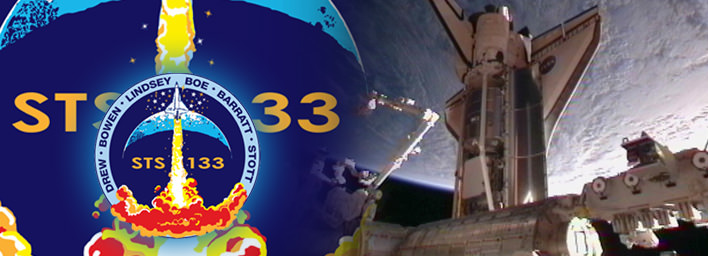
[/caption]
Space Shuttle Discovery linked up to the International Space Station (ISS) today, Feb. 26, on her historic final voyage and still charting new frontiers by carrying the first ever joint space crew of humans and robots.
The all veteran human crew is comprised of five men and one women including Commander Steve Lindsey, Pilot Eric Boe and Mission Specialists Alvin Drew, Steve Bowen, Michael Barratt and Nicole Stott. For the first time in the history of manned spaceflight, the humans are joined by a robotic companion named R2 or Robonaut 2. R2 is the first humanoid robot in space and will become an official member of the ISS crew.
See Discovery Launch, Docking and Robonaut photo album below.
Discovery docked at the ISS at 2:14 p.m. EST at the Harmony node while flying some 220 miles above western Australia. The shuttle arrived after a two day orbital chase that commenced with a picture perfect blast off on Feb. 24 from the Kennedy Space Center in Florida.
Shuttle Commander Steve Lindsey manually flew Discovery to join the two ships together. They have a combined mass of over 1.2 million pounds. This was Discovery’s 13th and final docking to the orbiting outpost. Discovery also was the first shuttle to dock to the ISS on the STS-96 mission on May 29, 1999.
After allowing the relative motions between the two ships to dampen out, the vehicles were then hard mated together. Hatches between the spacecraft were opened at 4:16 p.m. EST and the six Shuttle astronauts floated through the docking tunnel and into the station. They were welcomed by the six current residents already living and working aboard the ISS and thereby doubled the ISS human population to 12.
Prior to docking, Discovery executed a spectacular head over heels “back flip” with Commander Lindsey at the controls so that ISS crew members Paolo Nespoli and Cady Coleman could take hundreds of high resolution photographs of the shuttles critical heat shield tiles.
Over a period of nine minutes, Discovery rotated backward through a full 360 degrees during the dramatic maneuver with Earth as the backdrop.
The fragile thermal protection system (TPS) tiles protect the orbiter from the scorching heat generated during reentry through the Earth’s atmosphere. Specialists on the ground at the Johnson Space Center will pore over the images to look for any signs of tile damage which may have occurred during launch or on orbit.
Discovery’s cargo bay is loaded with a large new pressurized storage room and critical space parts for the space station. The primary goal of the STS-133 mission is to attach the new Permanent Multipurpose Module named “Leonardo” to the ISS which will provide additional living space for the station crews.
R2 is packed inside Leonardo along with science equipment, spare parts, clothing, food and assorted gear. The robot will serve as an assistant to the ISS astronauts and conduct science experiments and maintenance chores.
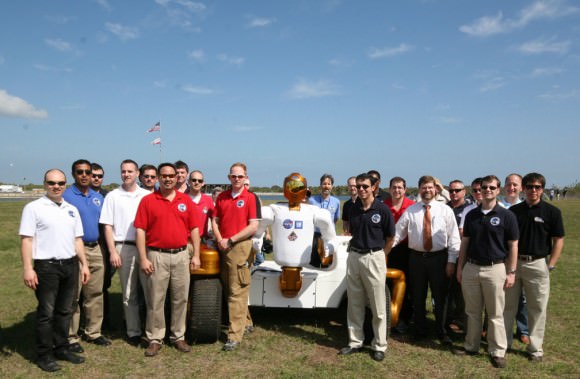
Robonaut 2 and the NASA/GM team of scientists and engineers watched the launch of Space Shuttle Discovery and the first joint Human-Robot crew on the STS-133 mission on Feb. 24, 2011 from the Kennedy Space Center. Credit: Ken Kremer
See a stunning 360 degree panorama of Robonaut 2 at KSC from nasatech.net at this link
The twin brother of R2 eagerly watched the Feb, 24 blastoff of Discovery and crew live from nearby the famous countdown clock at the Kennedy Space Center.
The 11 day flight includes two spacewalks.
With Discovery safely docked , the ISS is now the biggest it has even been and is currently configured with all vehicles which fly to the station including the newly arrived ATV from Europe, HTV from Japan and Soyuz and Progress spacecraft from Russia.
The ATV itself arrived docked barely 4 hours before Discovery in a critical operation that paved the way for blastoff of the STS-133 mission and reflects the magnitude of the ongoing orbital traffic jam at the ISS.
If all the STS-133 work is successfully accomplished, a Soyuz will undock towards the end of the STS-133 mission and stage a station fly around to capture the ultimate ISS photo op at the biggest it will ever be.
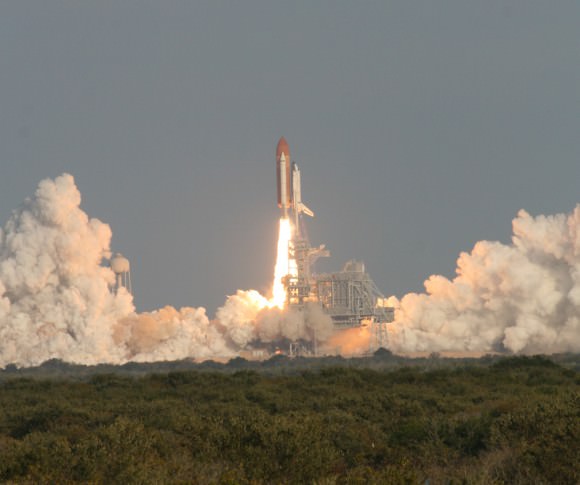
from launch pad 39 A at the Kennedy Space Center. Credit: Ken Kremer
Photo Album: Discovery executes dramatic back flip or Rendezvous Pitch Maneuver (RPM) as it approaches and docks at the ISS on Feb. 26, 2011
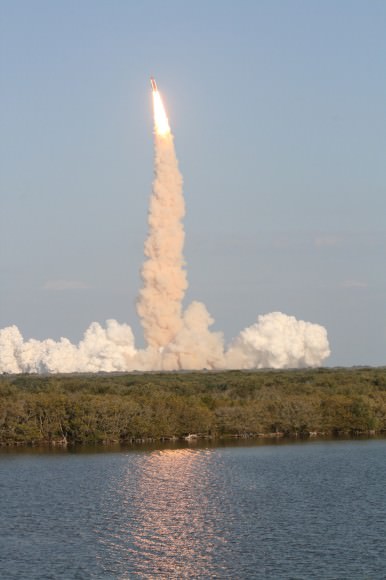
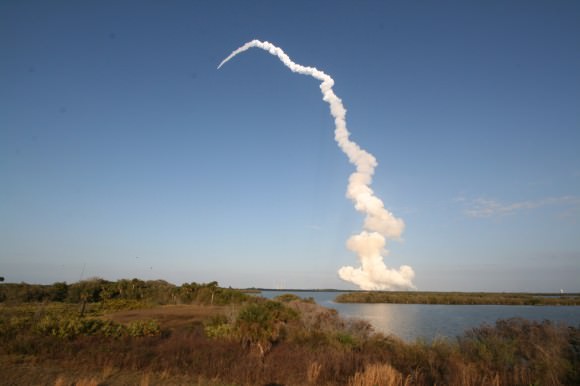
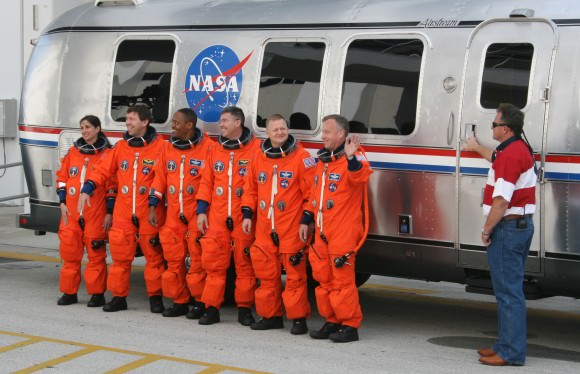
wave to large and enthusiastic crowd of space shuttle workers and media spectators before heading to the launch pad in the Astrovan for the STS-133 mission. From left are Mission Specialists Nicole Stott, Michael Barratt, Alvin Drew and Steve Bowen; Pilot Eric Boe; and Commander Steve Lindsey. Discovery will deliver the Permanent Multipurpose Module, packed with supplies and critical spare parts, as well as Robonaut 2 to the ISS. Credit: Ken Kremer
STS-133 Launch Day Gallery
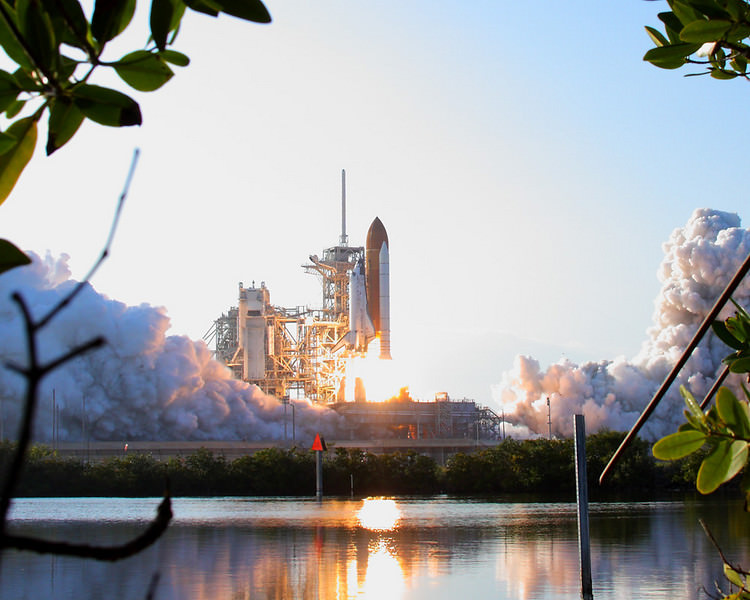
[/caption]
Here’s a collection of images from the historic final launch of space shuttle Discovery on February 24, 2011.
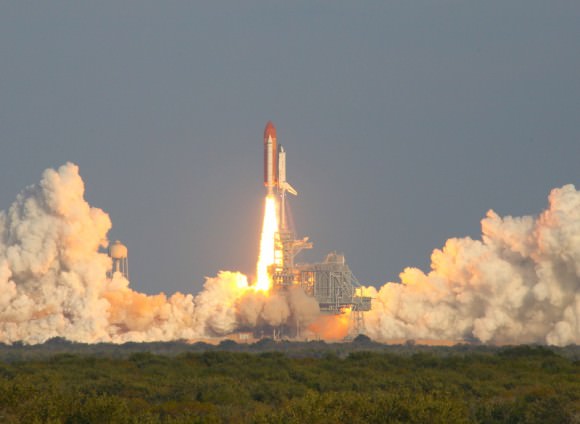
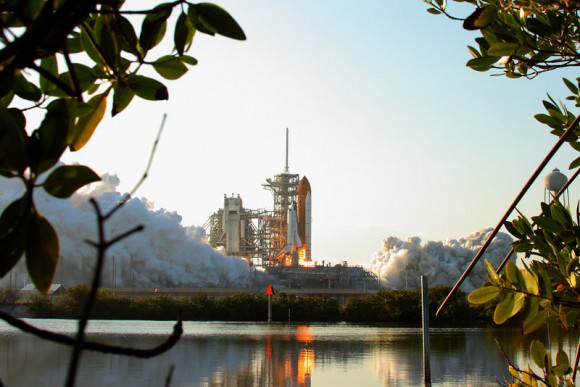
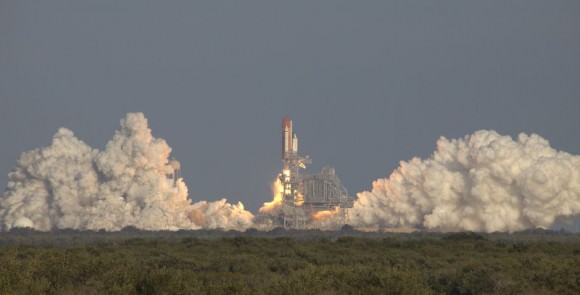
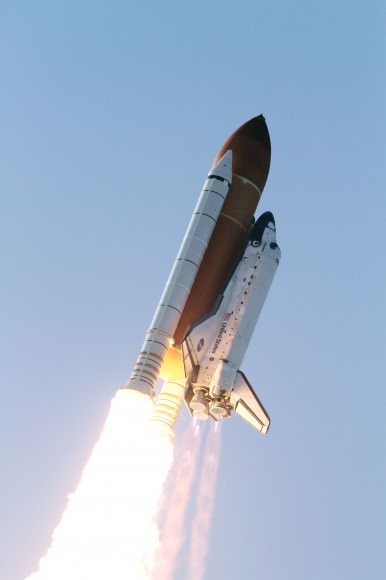
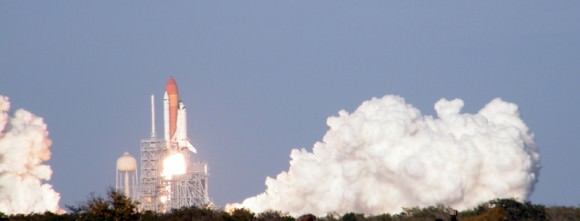
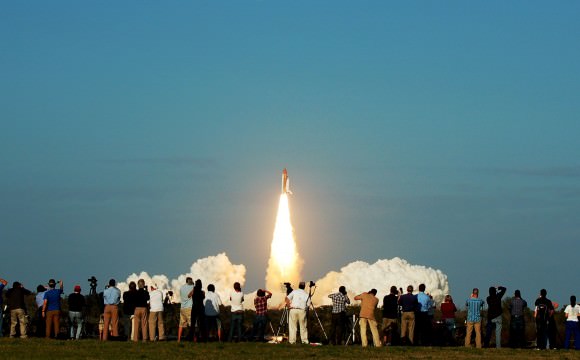
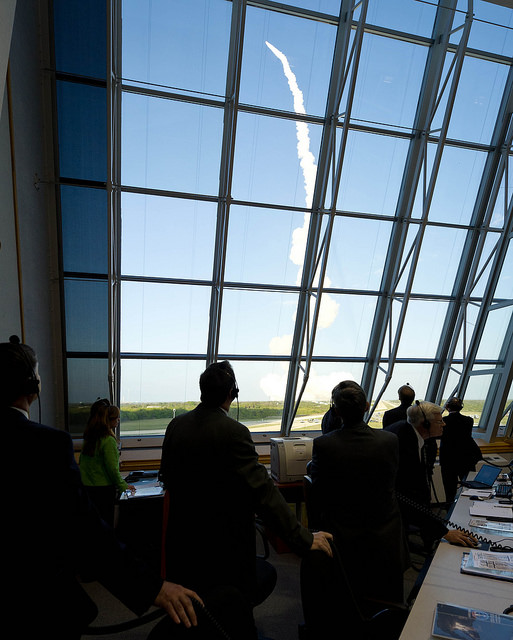
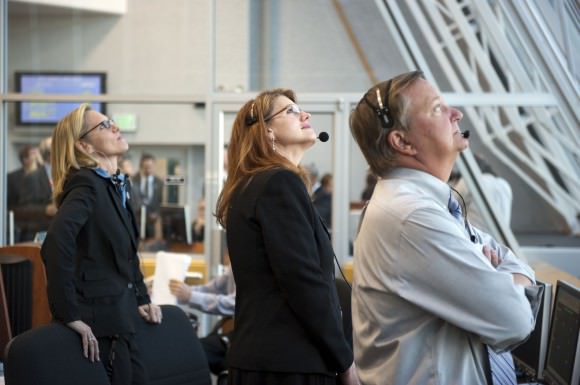
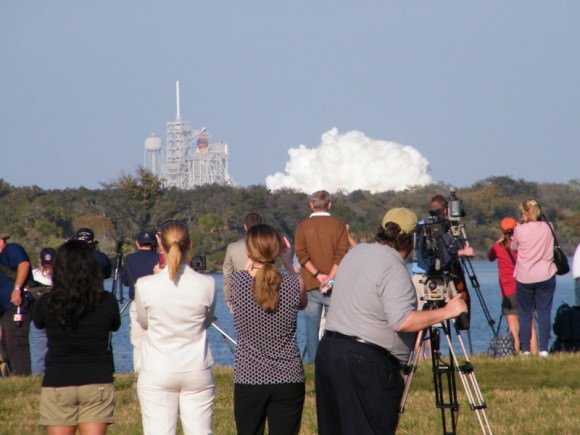
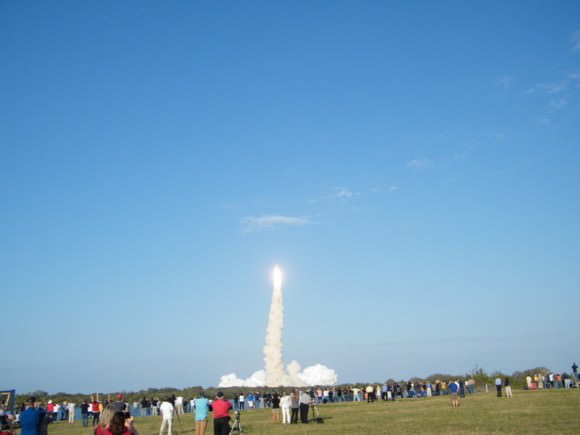
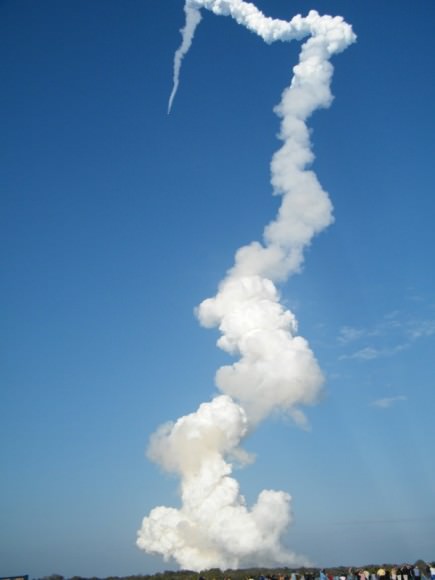
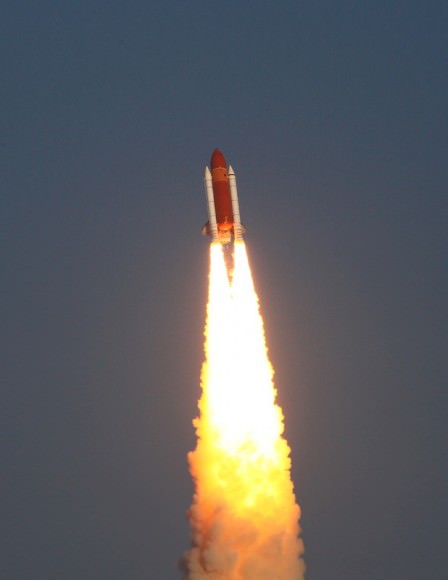
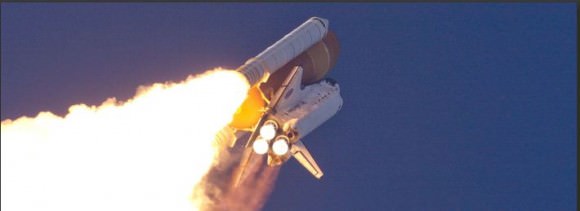
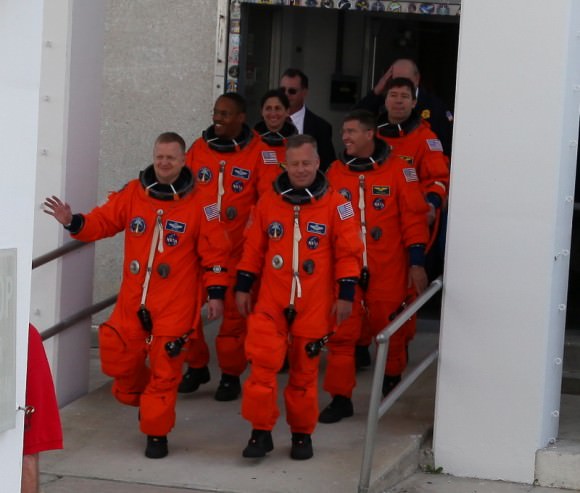
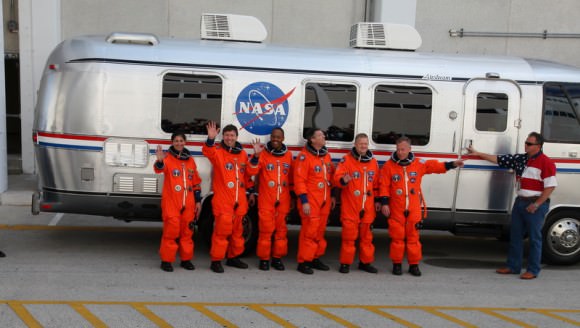
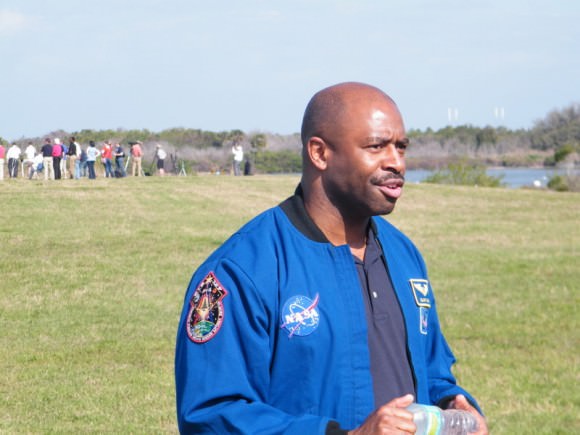
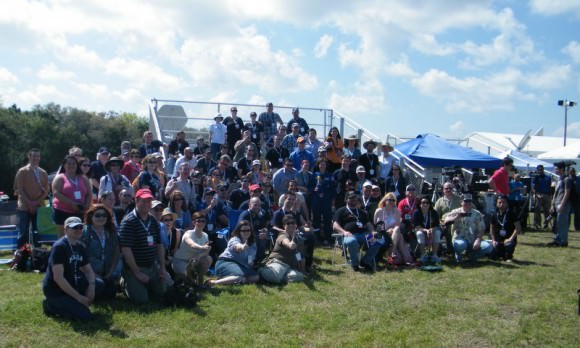
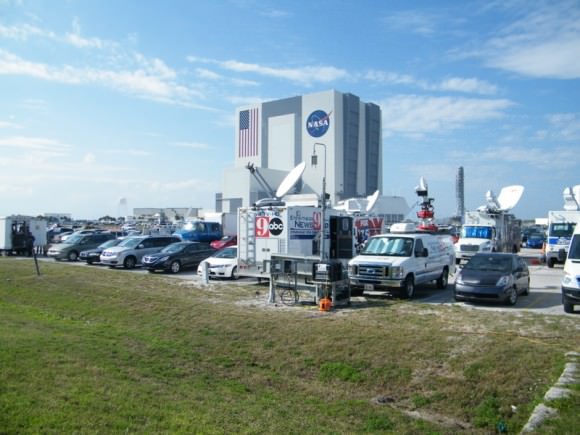
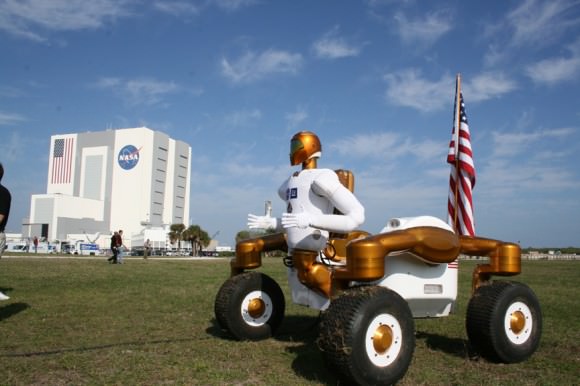
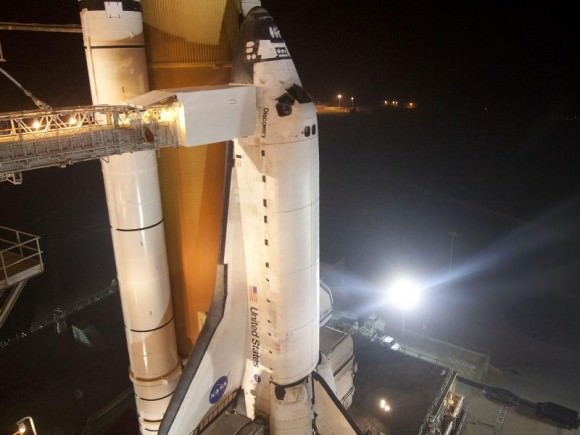
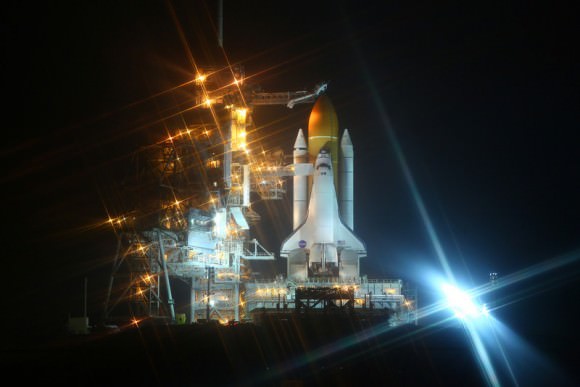
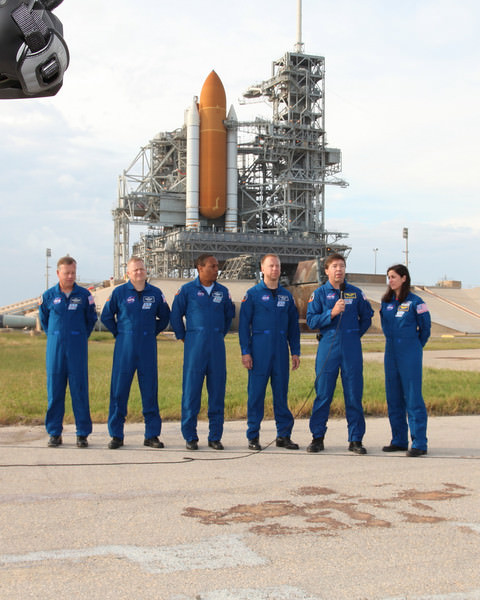
STS-133 Launches on Historic Final Mission for Shuttle Discovery
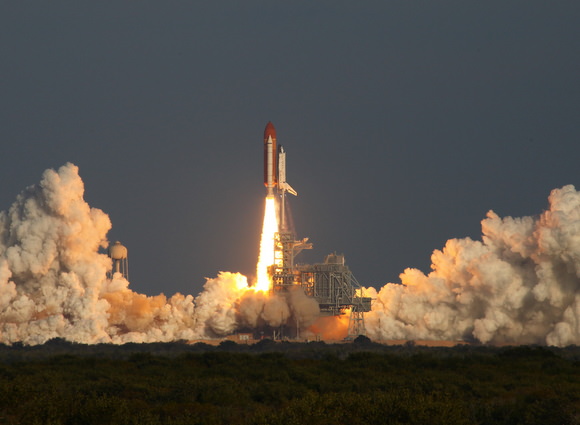
[/caption]
Overcoming a down-to the-last second problem, space shuttle Discovery made history today, launching on its final mission to orbit. The most-traveled orbiter is carrying a crew of six astronauts and one human-like Robonaut, along with a new permanent storeroom and supplies for the International Space Station. After waiting nearly four months following the detection of potentially dangerous cracks in Discovery’s external tank and a leak in the Orbiter Maneuvering System pod, a problem with a computer for the Air Force Range Safety Officer nearly thwarted the long-anticipated launch. The crew of STS-133 finally launched on their historic mission, with reinforced ribs, or stringers, in the tank’s “intertank” section and a leak-free OMS, and — two seconds before the launch window would have closed — a working computer in the Range. “That was about as last second as you can get,” said spokesman Allard Beutel from Kennedy Space Center.
Discovery set off on her final journey from a picture-perfect warm February day at Kennedy Space Center in Florida, thrilling enormous crowds of onlookers, a huge international press corp and dedicated Tweet-up attendees.
But the four month delay was not without consequences, as original STS-133 crew member Tim Kopra was injured in a bike accident, and Steve Bowen was chosen to replace him. The crew – which includes Commander Steve Lindsey, pilot Eric Boe, Nicole Stott, Michael Barratt, and spacewalkers Alvin Drew and Bowen — met at the base of the shuttle before climbing on board in a touching moment, giving each other a group hug before setting off on their mission.
In the payload bay is the Permanent Logistics Module – a glorified closet, with the first human-like robot, affectionately named R2, who will become a permanent crewmember on board the ISS.
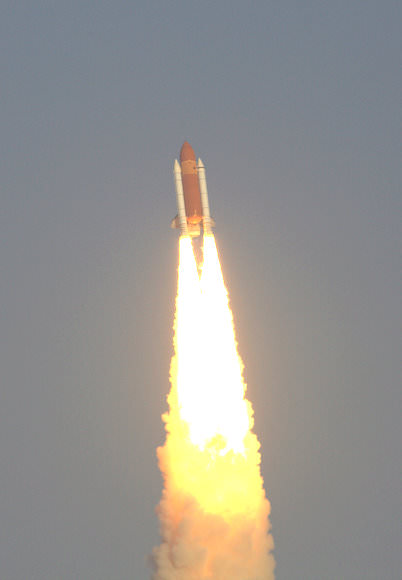
Discovery has been flying since Aug. 30, 1984. It’s first mission was 41-D, where astronauts deployed three communications satellites. Discovery has completed 30 successful missions, more than any other orbiter in NASA’s Shuttle fleet. The orbiter has undergone 99 different upgrades and 88 special safety tests – just since 2002. Discovery was named after several ships of exploration in human history.
Paving the way for the launch was today’s successful docking at the ISS of the ATV-2 Johannes Kepler, a European re-supply ship for the ISS. The Automated Transfer Vehicle 2 is the size of a double-decker bus, and carries 7 tons of supplies for the station’s six-person crew.
Here’s our huge gallery of launch images and here’s a video of the launch from NASA TV:
Students Will Attempt to Photograph Shuttle Discovery Flight At The Edge of Space
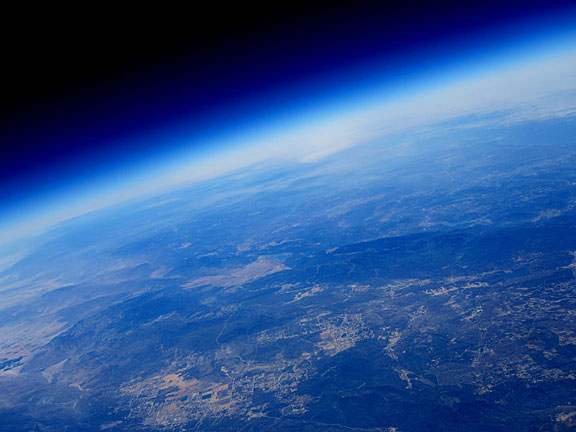
[/caption]
From a Challenger Center press release:
If all goes according to plan, a balloon with a student-oriented payload will photograph Space Shuttle Discovery as it climbs into space from an altitude of 100,000 feet. There will also be live streaming video from the balloon itself during the mission – sent back by two regular smartphones running Google’s Android operating system.
Co-sponsored by Challenger Center for Space Science Education, this mission is one in a series of flights conducted by Quest for Stars, a California-based non-profit educational organization that uses off-the-shelf hardware and a little ingenuity to allow students to place experiments at the edge of space at exceptionally low cost.
Quest for Stars and Challenger Center for Space Science Education have now joined together to promote the use of these low cost delivery systems. This mission will be the first of what is hoped to be many future collaborations.
A helium-filled balloon carrying the “Robonaut-1” payload (not related to the Robonaut-2 that is launching on board Discovery) will be launched from a location in Florida some distance away from Kennedy Space Center. The time and location of launch will be determined by weather conditions. With a currently planned STS-133 launch time of 4:50 p.m. EST, the balloon will be launched between 3:00 – 3:50 p.m. EST so as to be in position for Discovery’s supersonic transit of the stratosphere. If there is a delay in the launch of Discovery, the team is ready to try again – several times – on subsequent days.
The balloon will rise at a rate of 800-1,000 feet per minute to an altitude of approximately 100,000 feet. After accomplishing its mission, the payload will be released and descend by parachute. After the payload descends for 15-30 minutes, a trained recovery team will retrieve the payload and download its data and imagery.
Onboard Robonaut-1 is a HD Camera Phone Satellite (PHONESAT) that will attempt to capture images of Space Shuttle Discovery as it leaves Earth for space. Multiple cameras and an on-board computer system will ensure that Discovery launch images will be captured during its ascent. Some of those photos will include logos for Quest For Stars, STS-133, Challenger Center, and Motorola. In addition, the payload contains a Motorola i290 mobile phone and a Garmin eTrex GPS system that is connected to a ham radio transmitter. The payload is designed to have multiple means of communication for backup purposes.
Live video of mission activities will also be streamed during the mission. This webcast can be watched at http://www.ustream.tv/channel/chasing-discovery, http://www.challenger.org/live, and at http://onorbit.com/suborbital.
Live video from the Robonaut-1 itself during flight will be available at http://qik.com/robonaut-1.
Updates during the mission including live tracking information during ascent and descent can be obtained by following http://twitter.com/questforstars or on Facebook at http://tinyurl.com/4hu4337.
See more information and images at OnOrbit.com
Watch Live-Stream of Shuttle Launch on your PlayStation
[/caption]
Get a dose of reality via Sony’s PlayStation gaming system. The final liftoff of space shuttle Discovery on February 24, 2011 at 4:50 pm EST will be the first live streaming event to be offered by PlayStationHome, the social gaming networking service, and provide a unique “social viewing” environment.
“We’re excited about this new way for people to experience the exhilaration of human spaceflight as part of a larger community,” said David Weaver, NASA associate administrator for the Office of Communications. “In addition to the other two shuttle launches planned for April and June, NASA looks forward to sharing more of our endeavors with PlayStation users.”
The event is offered by Sunset Yacht, a premium personal space from LOOT, Sony DADC’s interactive entertainment development team. Users will be able to chat via Bluetooth headsets with others watching the launch – all from inside the PlayStation Home social gaming environment.
In addition to live streamed events, the Sunset Yacht’s NASA TV channel will offer hundreds of videos offering spectacular views of the universe from past and current NASA missions. A gallery of podcasts showcasing several missions including the Mars Science Laboratory and Voyager spacecraft also will be available from the agency’s Jet Propulsion Laboratory in Pasadena.
“The launch of the space shuttle Discovery provides a wonderful opportunity to introduce people to the fun of social viewing,” said LOOT Managing Director David Sterling. “Users can share this experience with their friends, regardless of where those friends happen to be in the world.”

